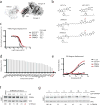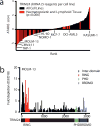Functional TRIM24 degrader via conjugation of ineffectual bromodomain and VHL ligands
- PMID: 29507391
- PMCID: PMC5866761
- DOI: 10.1038/s41589-018-0010-y
Functional TRIM24 degrader via conjugation of ineffectual bromodomain and VHL ligands
Abstract
The addressable pocket of a protein is often not functionally relevant in disease. This is true for the multidomain, bromodomain-containing transcriptional regulator TRIM24. TRIM24 has been posited as a dependency in numerous cancers, yet potent and selective ligands for the TRIM24 bromodomain do not exert effective anti-proliferative responses. We therefore repositioned these probes as targeting features for heterobifunctional protein degraders. Recruitment of the VHL E3 ubiquitin ligase by dTRIM24 elicits potent and selective degradation of TRIM24. Using dTRIM24 to probe TRIM24 function, we characterize the dynamic genome-wide consequences of TRIM24 loss on chromatin localization and gene control. Further, we identify TRIM24 as a novel dependency in acute leukemia. Pairwise study of TRIM24 degradation versus bromodomain inhibition reveals enhanced anti-proliferative response from degradation. We offer dTRIM24 as a chemical probe of an emerging cancer dependency, and establish a path forward for numerous selective yet ineffectual ligands for proteins of therapeutic interest.
Figures





References
-
- Darnell JE. Transcription factors as targets for cancer therapy. Nature Reviews Cancer. 2002;2:740–749. - PubMed
Publication types
MeSH terms
Substances
Grants and funding
LinkOut - more resources
Full Text Sources
Other Literature Sources
Molecular Biology Databases
Research Materials

